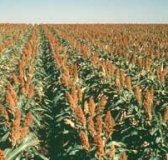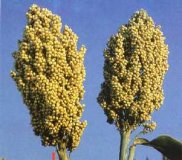Sorghum
http://www.100md.com
《e Natural Health Center》
 |
 |
 |
 |
Grains
Sorghum
Latin:
Sorghum vulgare
Origin:
Sorghum is the shelled edible seed of Sorghum vulgare (Pers.), Sorghum bicolor (L.) Moench., or Sorghum saccharatum ((L.) Moench.), a cereal grain plant belonging to the family Gramineae (Poaceae), probably originating in Africa.
, 百拇医药
Grain sorghum is utilized in food and industries around the world, as well as being a staple feed ingredient. Worldwide, more than 50 % of sorghum is grown directly for human consumption. Developing countries account for roughly 90 percent of the world's sorghum area and 70 percent of total output. Asia and Africa each account for about 25-30 percent of global production.
One of Africa's major cereal grains, sorghum is also cultivated in the United States, India, Pakistan, and northern and northeastern China. Substantial quantities are grown in Iran, the Arabian Peninsula, Argentina, Australia, and southern Europe.
, 百拇医药
All types raised chiefly for grain belong to the species Sorghum vulgare, which includes varieties of grain sorghums and grass sorghums, grown for hay and fodder, and broomcorn, used in making brooms and brushes. Grain sorghums include durra, milo, shallu, kafir corn, Egyptian corn, great millet, and Indian millet.
In India sorghum is known as jowar, cholam, or jonna; in West Africa as Guinea corn; and in China as kaoliang. Sorghum is especially valued in hot and arid regions for its resistance to drought and heat.
, 百拇医药
The strong grass usually grows to a height of 0.5 to 2.5 m, sometimes reaching as high as 4.5 m. Stalks and leaves are coated with a white waxy bloom, and the pith, or central portion, of the stalks of certain varieties is juicy and sweet. The leaves are about 5 cm broad and 0.75 m long, and the panicles, or flower clusters, range from loose to dense, bearing 800━3,000 kernels. It is in flower from August to October. The flowers are hermaphrodite (have both male and female organs) and are pollinated by wind.
, 百拇医药
The seeds vary widely among different types in color, shape, and size, but they are smaller than those of the wheat plant. The seeds are ripen from September to October. The plant cannot grow in the shade. It requires dry or moist soil and can tolerate drought.
Also called Broomcorn, Guinea Corn or Chinese Sugar-maple.
Properties:
Sweet and astringent in flavor, warm in nature, it is related to the channels of the spleen and stomach.
, 百拇医药
The characteristic strong flavor of sorghum can be reduced by processing.
Functions:
Warms the middle-jiao to strengthen the spleen and the stomach, excretes dampness and arrests dysentery.
Applications:
Sorghum is effective for insomnia coupled with dyspepsia (indigestion), due to weakness of the spleen-stomach functions.
, 百拇医药
It is also used to treat fluid retention due to hypofunction of the spleen, mal-digestion, dysentery and difficulty in urination resulting from damp-heat.
1. For dyspepsia in children:
Use 50 g red sorghum and 10 Chinese red dates. Discard the date stones and bake all together to brown. Grind as powder. Take 10 g twice daily. It was reported in 'Eating your Way to Health' that 104 cases were treated with the recipe, a hundred cases were cured within only 2 days; only the remaining 4 failed.
, 百拇医药
2. For diarrhoea:
Use the sorghum powder prepared as in the above recipe. Swallow with boiled water.
Dosage and Administration:
The sorghum grain is usually ground into a meal that is made into porridge, flatbreads, and cakes.
Sorghum is used as a whole grain in similar ways to rice or can be ground into a flour and made into bread, etc. The ground seed yields a particulary white flour.
, 百拇医药
Sorghum is a staple food in some regions, where it is often fermented (lactic acid fermentation) before being eaten.
The sprouted seed can be eaten raw, and is sometimes added to salads.
The sap of the sorghum plant can be eaten raw or cooked. It is very sweet, and has been made into a syrup.
The sorghum stem can be eaten cooked.
Cautions on Use:
, 百拇医药
The immature plant of sorghum is poisonous, for it can contain hydrogen cyanide.
In small quantities, hydrogen cyanide has been shown to stimulate respiration and improve digestion, it is also claimed to be of benefit in the treatment of cancer. In excess, however, it can cause respiratory failure and even death.
Reference Materials:
Toxic or Side Effects:
, 百拇医药
The immature plant of sorghum is poisonous.
Modern Researches:
Sorghum is of a lower feed quality than corn (maize). It is high in carbohydrates, with 10 percent protein and 3.4 percent fat, and contains calcium and small amounts of iron, vitamin B1, and nicotinic acid.
The sorghum grain is used in making edible oil, starch, dextrose (a sugar), paste, and alcoholic beverages. The stalks are used as fodder and building materials.
The decoction of the seed is soothing and diuretic. It is used in the treatment of kidney and urinary complaints.
Sweet sorghums, or sorgos, are grown mainly in the United States and southern Africa for forage and for syrup manufacture. In some countries the sweet stalks are chewed., http://www.100md.com